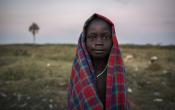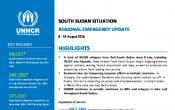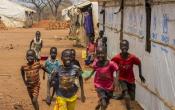South Sudan
Operation: South Sudan
Location
{"longitude":30,"latitude":7,"zoom_level":0}
Latest update of camps and office locations 13 Jan 2016. By clicking on the icons on the map, additional information is displayed.
Key Figures
| 2015 end-year results | |
| 12,001 | refugee ID cards distributed |
| 4,868 | emergency shelters and 4,072 transitional shelters constructed for vulnerable refugee households |
| 186,589 | IDPs with specific needs assisted with core relief items/emergency shelters |
| 163,000 | IDPs reached through protection assessment and monitoring |
| 1,080 | vulnerable people assisted to obtain nationality certificates |
| 2016 planning figures | |
| 100% | of refugee children targeted for enrolment in primary education |
| 75% | of refugees targeted to receive long-term/permanent shelter or transitional shelter |
| 7,500 | IDPs with specific needs receiving support |
| 142,500 | vulnerable IDP households receiving core relief items |
Latest Updates and Related Links
Last Updated 13 September 2016
People of Concern
2%
Decrease in
2015
2015
| 2015 | 2,054,441 |
| 2014 | 2,093,729 |
| 2013 | 561,117 |

[["Refugees",263016],["Asylum-seekers",839],["IDPs",1790427],["Returned refugees",159]]
Loading ...
Budgets and Expenditure for South Sudan
< Back
2015
{"categories":[2012,2013,2014,2015,2016],"budget":[265.31204645,220.15274604,423.03014037,413.880856341,275.66821274],"expenditure":[153.3296072,159.68388729,142.04241824,140.46294415,null]}
{"categories":[2012,2013,2014,2015,2016],"p1":[202.40813916,169.56500337,190.77653836,185.326305374,167.85975155],"p2":[2.99754561,9.31867217,8.77186352,6.53999141,4.79579352],"p3":[3.38841143,10.46680187,null,null,null],"p4":[56.51795025,30.80226863,223.48173849,222.014559557,103.01266767]}
{"categories":[2012,2013,2014,2015,2016],"p1":[124.84168863,140.4070933,86.74189326,96.29588561,null],"p2":[1.34545828,4.03534842,3.76620376,2.11256854,null],"p3":[2.67775157,4.86436034,null,null,null],"p4":[24.46470872,10.37708523,51.53432122,42.05449,null]}
Loading ...
CHOOSE A YEAR
- 2014
- 2015
- 2016
Working environment
- After the signing of the peace agreement in August 2015, large-scale fighting subsided although the situation remained volatile, generating new displacements.
- With the sudden deterioration of security in Western Equatoria, over 3,200 refugees fled Ezo camp, many returning to the Democratic Republic of the Congo (DRC). The situation prompted the relocation of refugees and the closure of the camp.
- Logistical and security challenges constrained UNHCR’s access to field locations.
- Despite many challenges, South Sudan maintained an open door policy for refugees.
Population trends
- Some 263,000 refugees were present in the country at year-end: 91% were from Sudan (20,000 new arrivals in 2015), with others originating from the DRC, Ethiopia and the Central African Republic.
- Some 1.7 million IDPs were in the country at year-end, including 185,000 in UNMISS Protection of Civilians sites.
Achievements and impact
- Refugee response - Together with the Government, UN and NGO partners, UNHCR delivered protection and multi-sectoral assistance for refugees. Health, WASH and nutrition indicators remained largely within emergency thresholds. Efforts were made to preserve the civilian character of asylum, to foster peaceful co-existence and to strengthen community-based protection. Ajuong Thok camp was expanded, and Pamir camp further developed, to accommodate new arrivals.
- IDP response - UNHCR worked to identify and address the needs of vulnerable individuals through protection monitoring, reporting and response, as well as through the deployment of mobile response teams. UNHCR continued to lead the protection cluster and to co-lead the CCCM cluster.
Unmet needs
- Refugee response - Gaps remained in upgrading the emergency structures and facilitating the access to education. More livelihoods assistance was needed to enhance self-reliance. Increased co-existence initiatives and environmental protection were required to mitigate the deterioration of the relations between refugees and host communities. The absence of an effective law enforcement capacity and of access to justice hindered the protection environment.
- IDP response - Access challenges affected UNHCR’s ability to improve the protection outreach and response and limited its geographical coverage to selected priority locations.
Working environment
Since the outbreak of the con¬flict in South Sudan in December 2013, continuing insecurity, and logistical constraints owing to heavy rains, have hampered the delivery of food and other essential items. Access to displaced people has been restricted, and refugees have faced serious protection concerns. At the same time, humanitarian workers have been at heightened risk. Six humanitarian workers were killed in a refugee-hosting area of Maban County in August 2014.The multiplicity of armed elements throughout South Sudan greatly exacerbated the challenge of re-establishing the civilian character of refugee camps in the north and north-east of the country. This also affected the protection environment with the erosion of law and order in refugee settlements and camps, as well as in surrounding communities.
Competition over scarce resources has in some places caused tensions and fighting between refugees and host communities. Greater attention must be paid to the needs of host communities in order to foster peaceful coexistence. This is important in order to minimize the risk of secondary displacement of refugees and further instability in the border regions.
Insecurity and access constraints have required the use of air transport for goods and humanitarian personnel, driving up the costs of delivering assistance and services to refugees and the internally displaced people (IDPs). The crisis has also stymied plans to improve camp-based refugees’ living conditions through the upgrading of emergency structures into more organized, sustainable constructions.
The South Sudanese civilian population at large is bearing the brunt of the confl¬ict, with some 1.4 million people uprooted by the end of September 2014. The continuing violence could also precipitate famine in the country, where millions suffer from food insecurity and varying degrees of malnutrition as they cannot plant, grow and harvest crops due to their forced displacement.
Needs and strategies
UNHCR will continue to encourage the Government of South Sudan to sign and ratify relevant international conventions and treaties related to the protection of refugees and the prevention of statelessness. The Office enjoys the support of the Commission of Refugee Affairs, which has established an active field presence in Unity and Upper Nile states hosting Sudanese refugees.In 2015, UNHCR’s main focus in South Sudan will be to respond to the needs of Sudanese refugees in the camps. The overarching priority will be to upgrade emergency structures in all camps and enhance the shelter, health, education, water, sanitation and hygiene sectors to improve the current standards. Protection priorities will include: maintaining the civilian character of refugee settlements; improving access to and the quality of education, as a means of preventing child recruitment and child labour; enhancing the monitoring of sexual and gender-based violence (SGBV) and referral of cases; harmonizing access to assistance for individuals with specific needs; promoting peaceful coexistence among refugees and host communities; and strengthening the Government’s capacity to respond to the protection needs of refugees.
Basic services, self-reliance and identification of durable solutions will be pursued for non-Sudanese refugees remaining in camps/settlements. Protection and basic services will be continued for urban refugees, and the Office will also promote the distribution of identity cards. UNHCR will continue facilitating voluntary repatriation of refugees whenever possible. In addition, community-based activities will be implemented for refugee/IDP returnees to support their smooth and sustainable reintegration process.
The Office will support the Government in processing applications for nationality and identity documentation to prevent statelessness.
With regard to IDPs, UNHCR, as a part of the Humanitarian Country Team in South Sudan, will lead or actively engage in the response efforts in the area of protection, camp coordination and camp management (CCCM) and shelter/non-food items (NFIs), targeting the most vulnerable IDPs including those displaced outside the Protection of Civilians sites.





